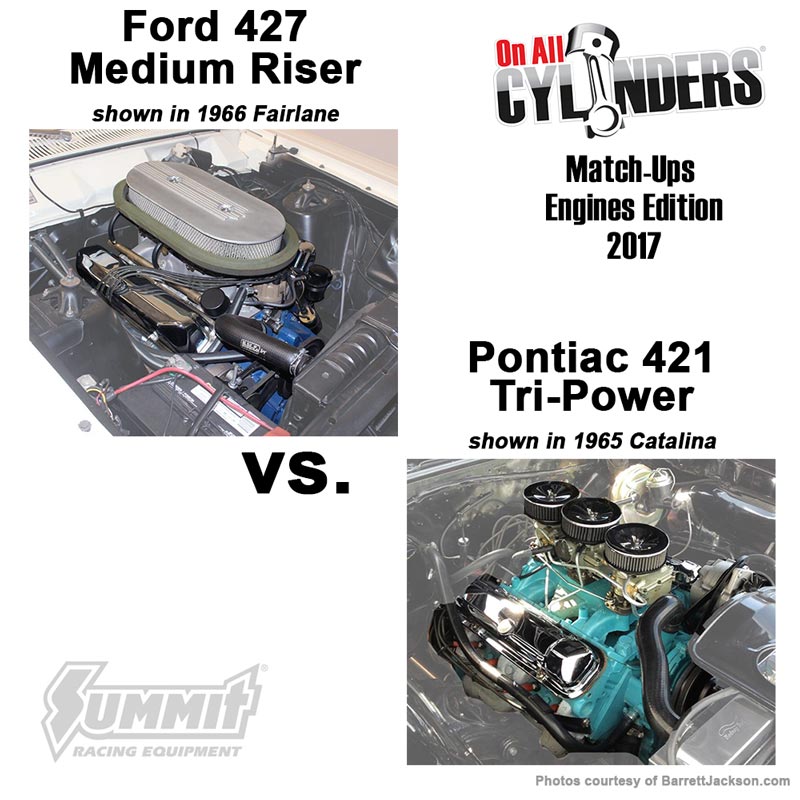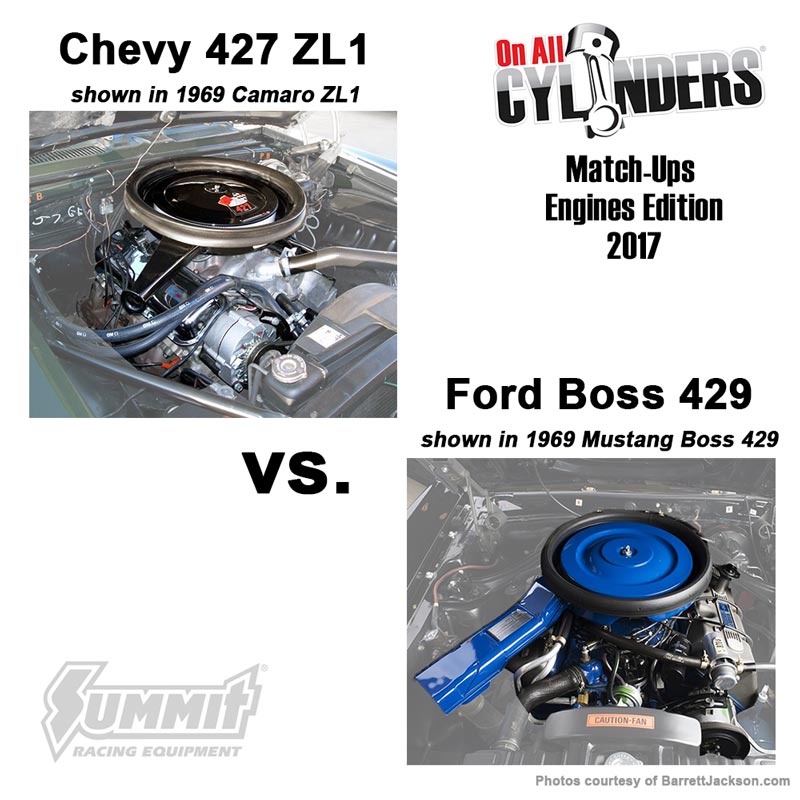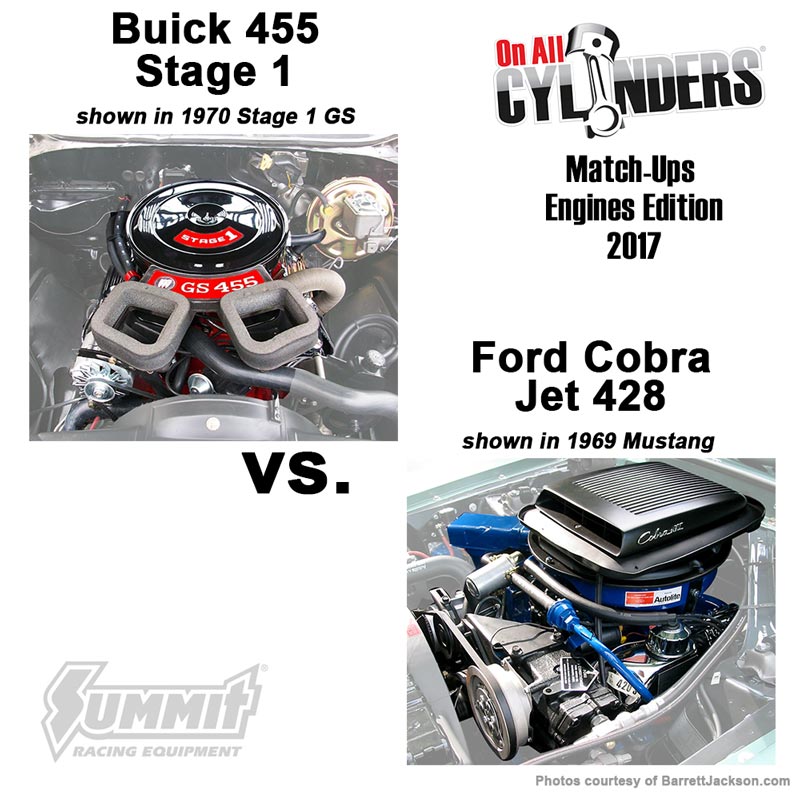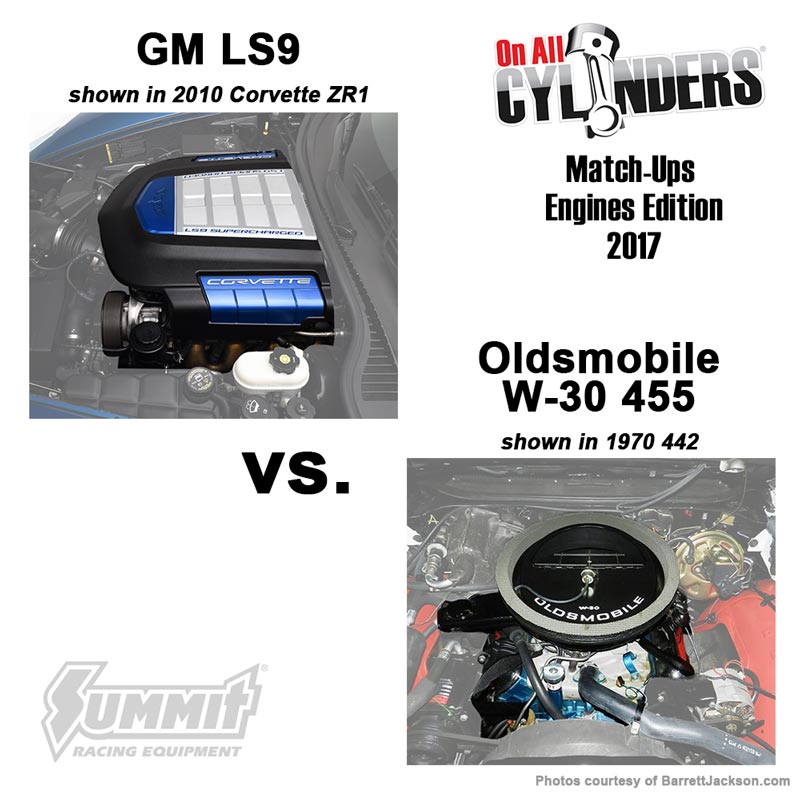The NCAA basketball tournament has been a tradition since 1939. Our annual Muscle Car Match-Up tournament hasn’t been around nearly that long, but we felt it was already time for a change.
So, for 2017, we present the OnAllCylinders Muscle Car Match-Ups…Engine Edition!
That’s right — we’ve stripped our tournament of the cars but left all the muscle! These are the Mike Kryshevski, Mike Khryzewsky, Mike Krysweski, Coach K’s of the muscle car world. These are the driving forces behind the most formidable cars of all time. Much like Coach K, or John Wooden, they’re legendary forces that have created unstoppable machines. And much like Bob Knight, they’re just plain mean.
Now it’s up to you to vote for the best engine in American muscle car history. Is it the one that’s most powerful? Or is it the powerplant that’s responsible for making the most cars legendary? Or maybe it’s a game-changing engine that combines power and efficiency.
Carbureted or fuel-injected…Chevy, Ford, Mopar, or whatever…it’s entirely up to you to name the best muscle car engine ever!
How it Works
See the entire bracket at the bottom of the story, and our first-round match-ups below. You can vote for your first round winners in one of three ways:
- Write all your first round picks in the comments section below.
- Follow OnAllCylinders on Facebook and vote on each individual match-up when we post it. You make your pick by commenting on your favorite.
- Follow Summit Racing Equipment’s Facebook page. Our friends at Summit Racing will post individual, head-to-head match-ups from the tournament, and you can comment on your favorite to vote.
Chevy 454 LS6 vs. AMX 390
When General Motors lifted the 400-cubic-inch ceiling on engines for its intermediate cars, the company went all-in by bumping its 427 engine up to 454 cubic inches. There were a few versions of the 454, but the most powerful offered to the general public was the 450-horse LS6 version. It featured an 800 cfm Holley bolted to an aluminum intake, and utilized a solid lifter cam for a 6,500 redline. In its debut year of 1970, the Chevelle 454 LS6 vied for king of the performance mountain with the Mopar HEMI.
The AMX 390 is the brash underdog of this competition. At 325 horsepower, it doesn’t have the oomph of the LS6—but it was perfect for the Hurst SC/Rambler. The 390’s power was more than enough to make the lightweight AMX a formidable opponent with 14-second ETs from the factory. If uniqueness counts, the AMX 390 might be your Cinderella story this March.
…
Chrysler 440 Six Pack vs. Chevy L88 427
For 1969, Chrysler wanted something more streetable and economical than the HEMI, but that could still deliver comparable power. And boy did they find it! The new 440 Six Pack delivered 390 horsepower and 490 ft.-lbs. of torque (same as the HEMI) in a distinctive package that required less tuning than the 426. A trio of Holley 2-barrel carburetors earned the engine its “Six Pack” moniker and helped make it a legend!
Very few big blocks can make a Chevrolet enthusiast smile as quickly and easily as the L88. The Chevy L88 427 was a competition-grade version of the 427 that used a racing cam, solid lifters, high-flow aluminum heads, and other competition parts. Available from 1967-69, the legendary L88 Corvette produced over 430 horsepower, although that number is thought to be grossly underrated.
…
Ford 427 Mid Riser vs. Pontiac 421 Tri-Power

The Ford 427 is arguably Ford’s most iconic engine. The best and most streetable of the production-line 427s was the Ford 427 Mid Riser, which was available on select Fords during the 1960s. Fairlanes, Galaxie XLs, and some select GT500s were among the legendary cars that could be had with a 427 Mid Riser. The top-of-the-line 427 Mid Riser was a dual-quad equipped version that produced 425 horsepower.
The Pontiac 421 Tri-Power was essentially a de-tuned version of the 421 Super-Duty, which was used extensively in Pontiac’s race program. It borrowed cylinder heads from the Super-Duty program, employed an aggressive hydraulic camshaft, and featured Pontiac’s now-famed Tri-Power induction setup. It could have been the engine that powered the legendary ’64 GTO, but was simply too big and powerful (370 horsepower) for Pontiac’s strict power-to-weight ratio restrictions.
…
GM LS9 vs. Oldsmobile W-30 455
Pardon us for allowing a “small block” on our list. If you’re an old-school muscle car purist, you may also not like that the GM LS9 is a modern, fuel-injected engine with forced induction. But 638 horsepower and 604 ft.-lbs. of torque made us look the other way on this one—and we won’t apologize! At just 376 cubic inches, the LS9 packs a wallop, especially coming from such a lightweight package.
When GM lifted its ban on engines larger than 400 cubic inches, Oldsmobile equipped its famed 4-4-2 with its W-30 455 big block. Nicknamed the “W-Machine Package,” this engine was loaded with performance-minded features that set it apart from the competition. An aggressive cam, Force-Air induction via twin scoops, and a lighter-weight aluminum manifold helped the W-30 make 370 horsepower and a whopping 500 ft.-lbs. of tire-shredding torque!
…
Chevy 427 ZL1 vs. Ford Boss 429

When Chevrolet dreamed up the all-aluminum Chevy 427 ZL1 engine, its intended purpose was to be a lightweight road-racing engine, and not for street vehicles. But then car dealer Fred Gibb famously leveraged Chevy’s Central Office Production Order system to special-order Camaros stuffed with ZL1 427 engines (which weighed more than 100 pounds less than their iron counterparts). The ZL1 was rated at 430 horsepower at 5,200 rpm and 450 ft.-lbs. of torque at 4,440 rpm, but experts say the engine’s actual power was around 500 horsepower at 6,400 rpm.
Similar to the ZL1, the Ford Boss 429 Mustang was conceived so that the engine could compete in motorsports. Racing versions of the Boss 429 were made for NASCAR Ford Torino race cars. But because of NASCAR rules mandating that at least 500 cars be sold with any engine used for NASCAR racing, Ford Motor Co. had to give the 429 a production-vehicle engine bay to call home. (Thanks NASCAR!) Ford rated the Boss 429 at 375 horsepower (for the 1,358 produced between 1969 and 1970) , but dyno-testing shows it made more like 600 horsepower.
…
Chrysler 426 HEMI vs. Pontiac 400 Ram Air III

The Chrysler 426 HEMI might have the best origin story of any engine, ever. It debuted under the hood of various NASCAR race cars at the 1964 Daytona 500 and finished 1-2-3 at the event. Nicknamed “The Elephant” because of its size, the 426 HEMI’s dominance prompted NASCAR officials to change the rules, requiring that race teams use engines available in production vehicles. Chrysler sat out the following year, developed the street version of the HEMI which debuted in all those great 1966 B-Bodies. The slightly detuned street 426 HEMI offered 425 horsepower at 5,000 rpm and 490 ft.-lbs. of torque at 4,000 rpm.
The Pontiac 400 Ram Air III was the standard engine for the legendary 1969 Pontiac GTO Judge. The vaunted Ram Air III will be forever linked to the Judge, but is also the mill that powered the 1969-70 Pontiac Firebird Trans Am. The engine made 345 horsepower at 5,000 rpm, and produced 430 ft.-lbs. of torque at 3,400 rpm. Will that scare the HEMI purists? Maybe not. But should the Ram Air III be trifled with? At your peril.
…
Buick 455 Stage 1 vs. Ford Cobra Jet 428

In base form, the 455-cubic-inch V8 already was nothing to sneeze at, but the Buick 455 Stage 1 (a $115 upgrade) featured cylinder heads designed to accept larger 2.12/1.75-inch intake/exhaust valves, and increased compression from 10.0:1 to 10.5:1. The Stage 1 also boasted a more-aggressive camshaft with intake/exhaust lift of 0.490” with 316/340 degrees of duration. Buick gave the Stage 1 a factory rating just 10 horsepower more than the base engine, but it’s commonly accepted among muscle car historians that it added closer to 50, for a total output near 400 horsepower.
Many are familiar with the story of Bob Tasca—the Providence, RI car dealer who first shoved a 428-4V Police Interceptor engine under the hood of his 1967 Ford Mustang because he found the original 390-cubic-inch engine lacking. Tasca’s creation also convinced Ford officials to put the 428 in the Mustang and Fairlane, as well as the Mercury Cougar and Comet. The 428 GT engine program was eventually renamed “428 Cobra Jet.” According to retired Ford engineer Bill Barr, the 428 Cobra Jet produced 411 horsepower and 418 ft.-lbs. of torque.
…
6.2L Hellcat vs. Pontiac SD-455

There’s very little mystery surrounding the instant interest and fondness for Fiat Chrysler’s 6.2L Hellcat engine when it debuted in the 2015 Dodge Challenger SRT Hellcat. The engine makes 707 horsepower right from the factory floor. Marry that to its pavement-grinding 650 ft.-lbs. of torque, and you have the most powerful factory muscle car ever, spitting out power numbers similar to supercars from Ferrari and Lamborghini. It stands to reason that Fiat Chrysler would want to add Hellcat power to other vehicles, like the Dodge Charger and Jeep Grand Cherokee. So they did.
The Pontiac SD-455 was first produced in 1973 when other automakers were pulling back on performance vehicle production. “SD” stands for “Super-Duty,” a worthy moniker for the 1974 Pontiac Firebird Trans Am. General Motors held back the beefy engine, releasing it into the wild with a net rating of 290 horsepower and 395 ft.-lbs. of torque. What only Pontiac engineers could know right away, but would later be realized by the muscle car enthusiast masses, is that the SD-455 offers enormous potential for adding more power.





1. Chevy 455 LS6
2. Chevy L88 427
3. Ford 427 Medium Riser
4. GM LS 9
5. Ford Boss 429
6. Chrysler 426 Hemi
7. Ford 428 Cobra Jet
8. 6.2L Hellcat
love that HEMI
1. Chevy 454 ls6
2. 2. Chevy L88 427
3. Ford 427 medium riser
4. GM ls9
5. Ford Boss 429
6. Chrysler 426 Hemi
7. Ford 428 cobra jet
8. 6.2l hellcat
How come there’s engines left out?? Like the twin cam Ford coyote, and the chevy 572? 327, 350, 283?? What about the LT1?
572??? What production car did that come in???
Quit whining. They could never make an all-inclusive list that satisfied everyone.
I got a 1964 283 in my 2001 S10 shorty and drive it every day. Not enough horsepower to compete with any thing on the list. But, still fun and a ton of smiles burning rubber every day.
1. LS 6
2. L88
3. Medium Riser
4. LS 9
5. 429 Boss
6. 426 Hemi
7. 429 Cobra Jet
8. Hellcat
Amx 390
440 six pack
427 mid rise
Ls9
ZL1
400 ram air 3
Cobra jet 428
SD 455
1. Chevy 455 LS6
2. Chevy L88 427
3. Ford 427 Medium Riser
4. GM LS 9
5. Ford Boss 429
6. Chrysler 426 Hemi
7. Ford 428 Cobra Jet
8. 6.2L Hellcat
1-LS6
2-L88
3-Tri-Power
4-W-30
5-ZL1
6-Hemi
7-Stage 1
8-SD 455
Chevrolet 454LS, Chrysler 440 six pack, Pontiac 421 tri power, GM LS9, Chevrolet 427 ZL1, Chrysler 426 Hemi, Buick 455 Stage1and Pontiac SD-455
Chevy 454 LS6
Chrysler 440 6-Pack
Pontiac 421 Tri-Power
Olds 455 W-30
Ford Boss 429
Pontiac 400 Ram Air III
Buick 455 Stage 1 (510 Lb-Ft @ 2800 RPM!)
Pontiac SD-455
1. Chevy 454 LS6
2. Chrysler 440 Six Pack
3. Ford 427 Medium Riser
4. Oldsmobile W-30 455
5.Ford Boss 429
6. Chrysler 426 Hemi
7. Ford Cobra Jet 428
8.Pontiac SD-455
amx 390
AMX 390
1.AMX 390
2.Chevy L88 427
3.Ford 427 Medium Riser
4.Olsmobile W-30 455
5.Ford Boss 429
6.Chrysler 426 HEMI
7.Buick 455 Stage 1
8.6.2L Hellcat
1). LS6, 2). L88, 3).Pont 421 Tri, 4). LS9, 5). ZL1/Boss 429 = Tie, 6). 426 Hemi, 7). Cobra Jet 428, 8). SD-455
1. AMC 390
2. Chrysler 440 six pack
3. Pontiac 421 tori power
4. Oldsmobile 455
5. Ford boss 429
6. Chrysler 426 HEMI
7. Ford Cobra Jet 428
8. 6.2L hellcat
[…] course you do! That’s why you filled out your bracket in the 2017 Muscle Car Match-Ups (Engine Edition), and why you want to see some of the most potent, powerful engines at the 2017 Summit Racing […]
1. Chevy 454 LS6 vs. AMX 390 = 454 LS6 WIN.
2. Chrysler 440 Six Pack vs. Chevy L88 427 = 440 Six Pack WIN.
3. Ford 427 Medium Riser vs. Pontiac 421 Tri Power = Ford 427 WIN.
4. GM LS9 vs. Oldsmobile W-30 455 = GM LS9 WIN.
5. Chevy 427 ZL1 vs. Ford Boss 429 = Ford Boss 429 WIN.
6. Chrysler 426 Hemi vs. Pontiac 400 Ram Air III = 426 Hemi WIN.
7. Buick 455 Stage 1 vs. Ford Cobra Jet 428 = Cobra Jet 428 WIN.
8. 6.2 Hellcat vs. Pontiac SD-455 = 6.2 Hellcat WIN.
1. LS6
2. L88
3. Ford 427
4. LS9
5. Boss429
6. 426 Hemi
7. 428 Cobra Jet
8. 6.2 Hellcat
AMX 390
BUICK 455 STAGE 1
1. 454 LS6
2. Chrysler 440
3. Pontiac 421
4. GM LS9
5. Chevy 427
6. Hemi
7. 455
8. 455
Guess I’m not a Ford fan.
[…] the best of the best American V8s below. Which one is THE best? It’s up to you to decide—see how the voting is done here. Don’t miss your chance to crown your favorite […]
1. Chevy 455, 2. Chevy 427, 3. Pontiac 421, 4. Olds 455
Ls9 and hellcat
yep, LS9 and Hellcat
[…] to this point—the Buick 455 Stage 1. Which one is THE best? It’s up to you to decide—see how the voting is done here. Don’t miss your chance to crown your favorite […]
427 Ford and Buick 455 Stage 1
455 Stage 1 BUICK.
Stage 1 455 monster
Buick Stage 1
Pontiac SD455
426 HEMI
Olds W30 455
Pontiac 421 Tri-Power
440 Six Pack
454 LS^
Buick 455 Stage 1 all day!
455 Stage 1 Buick!
[…] Don’t miss your chance to crown your favorite powerplant. See how the voting is done here. […]
Not sure how the Pontiac Ram Air 3 made the contest instead of the Ram Air 4. The Air 4 had the legendary “round port” heads, more cam than the Air 3, and those awesome tuned exhaust manifolds specific to the Ram Air 4. Air 4 came with one of the best factory aluminum intakes ever made. Air 3 was cast iron. But a lot of great engines didn’t make the list. No Cobra Jet 428/429’s. No Buick 455 Stage 1. Maybe next time I suppose.